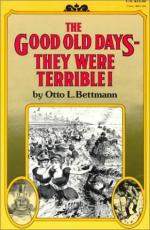|
This section contains 333 words (approx. 1 page at 400 words per page) |

|
Chapter 7, Food and Drink Summary and Analysis
The average citizen of the late 19th century was forced to subsist on a monotonous, simple diet that was oftentimes far from healthful.
There was no meat-packing industry. Meat arrived "on the hoof," that is, live, on rail. Many cows were dying of starvation or sick well before the slaughterhouse. Meat was often decayed, or left to hang outdoors, which meant very quick deterioration. One might think many citizens would turn to vegetables given this kind of meat, but in fact vegetables were widely blamed for a cholera epidemic in 1832, and people were still distrustful of fruit and vegetables.
Milk was not only diluted with water, but colored with chalk or plaster of Paris in cases when the milk was contaminated or spoiled. Swill milk, from cows fed waste, was a particularly nasty form of...
(read more from the Chapter 7, Food and Drink Summary)
|
This section contains 333 words (approx. 1 page at 400 words per page) |

|




